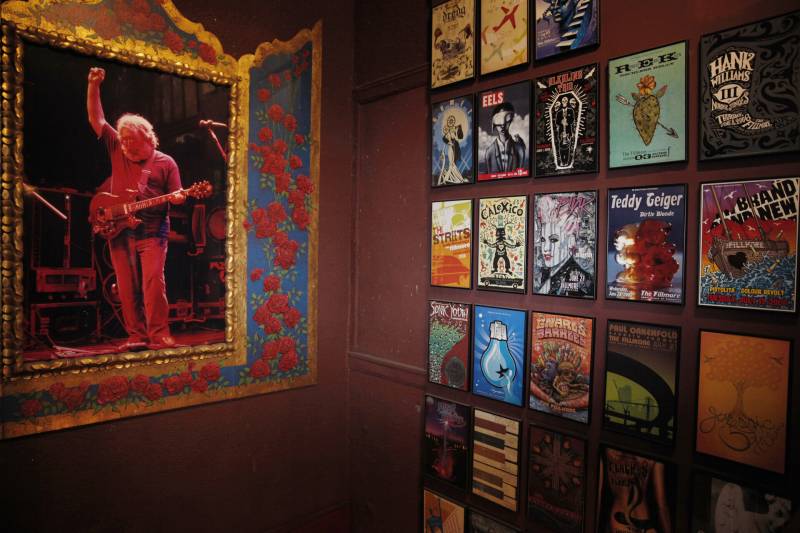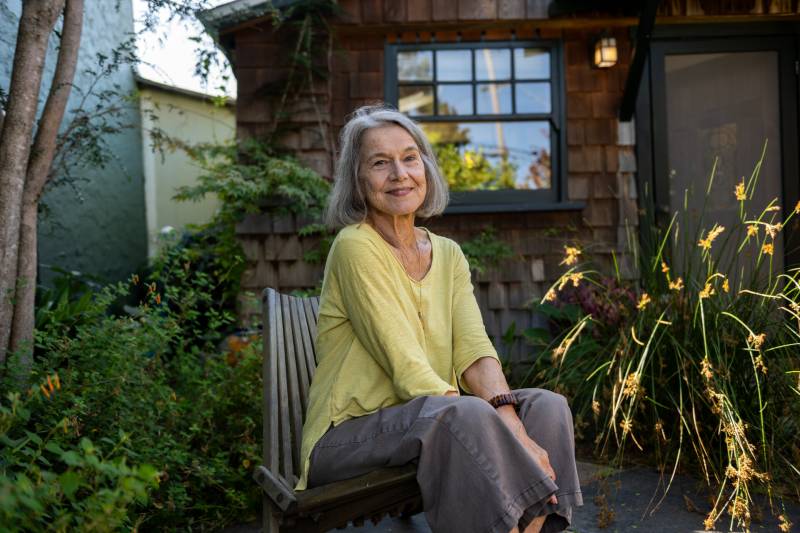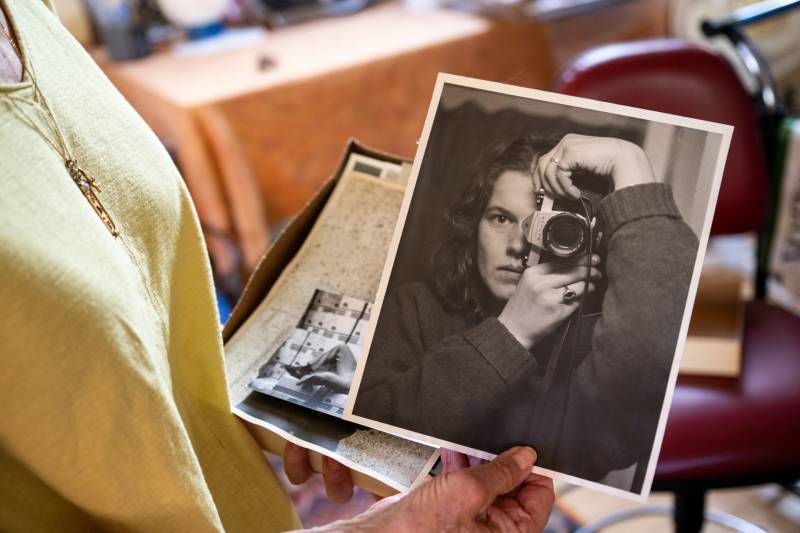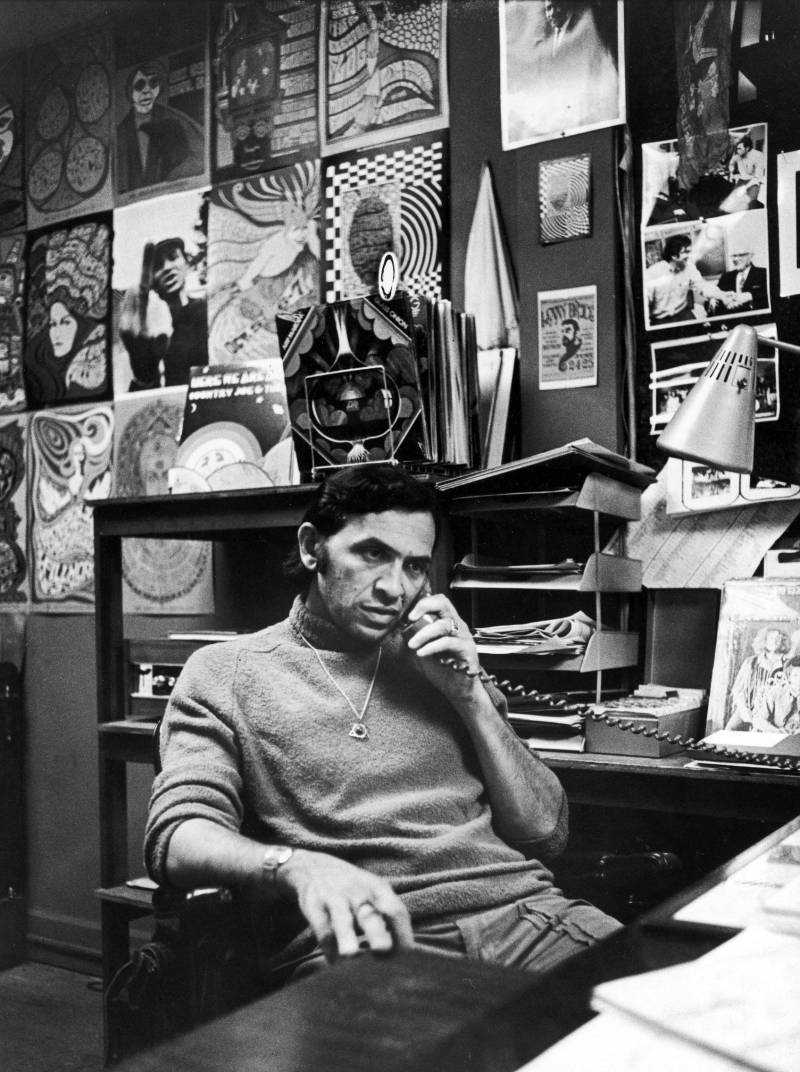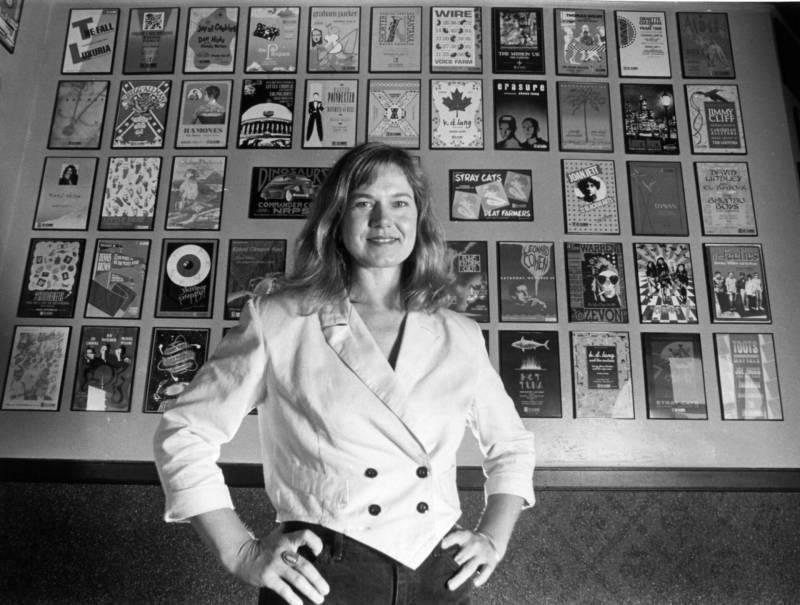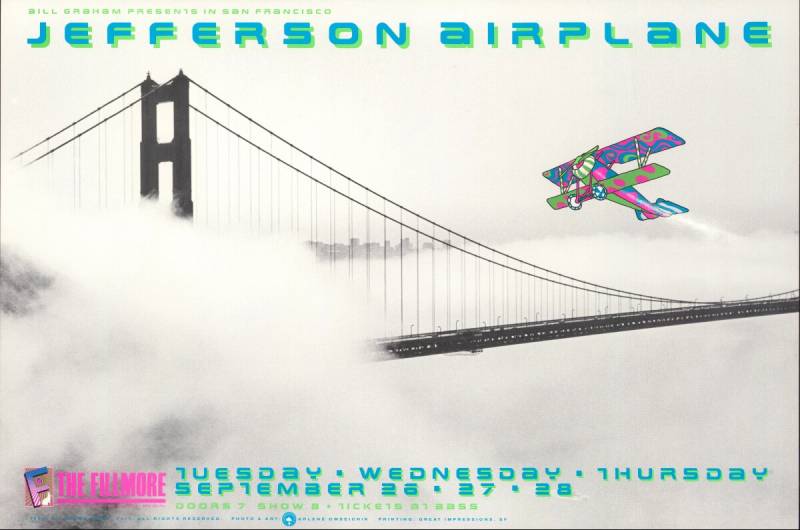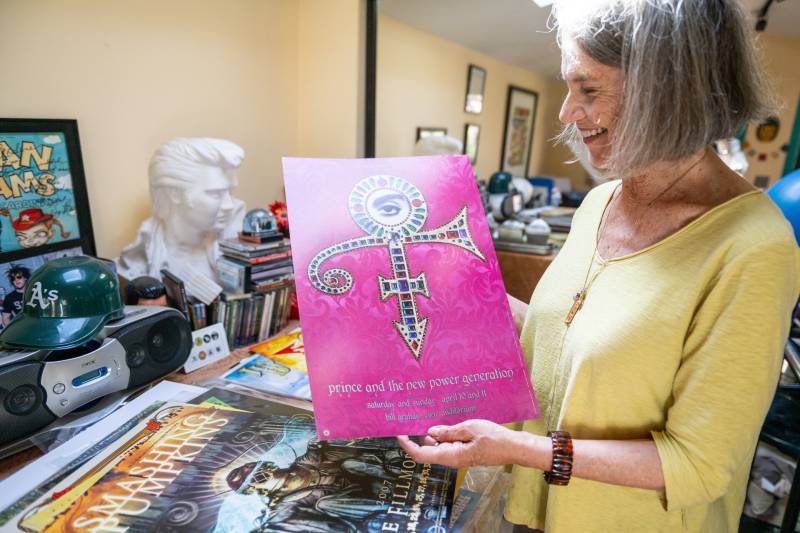Episode Transcript
This is a computer-generated transcript. While our team has reviewed it, there may be errors.
Olivia Allen-Price: Years ago, Bay Curious listener Ben Kaiser was seeing a show at San Francisco’s Fillmore Auditorium … The Psychedelic Furs.
[The Psychedelic Furs, “Love my Way” plays]
Olivia Allen-Price: It was a great show. The kind he’ll remember forever.
Ben Kaiser: And luckily, that night, they were offering a free poster to everybody in attendance. That was my first poster of the Psychedelic Furs.
Olivia Allen-Price: It’s now framed in his Atlanta home.
Ben Kaiser: It’s a very dark and moody poster. It looks like somebody standing in an alley, walking away from the perspective of the viewer. It’s a beautiful poster.
Olivia Allen-Price: Free posters are a beloved parting gift for concert-goers at the Fillmore. They’re never guaranteed, only given out at the biggest shows. And they’re created just for the Fillmore audiences — so when folks do get one, it’s special.
Ben Kaiser: These posters are artifacts, pieces of time. They’re as much of the concert as the concert.
Olivia Allen-Price: At this point, the free posters are almost as legendary as The Fillmore Auditorium itself — a center stage for the counterculture music scene during the 1960s. Bands like Santana, Quicksilver Messenger Service, and Janis Joplin’s Big Brother and the Holding Company launched their careers on that stage. The Grateful Dead played there more than 50 TIMES.
[The Grateful Dead “Friend of the Devil” plays]
Olivia Allen-Price: The posters. The venue. It’s history! This all got Ben wondering…
Ben Kaiser: The Fillmore is legendary. The posters at the Fillmore are legendary. The poster wall at the Fillmore is legendary. But what I would like to know more about is the person behind the poster.
Olivia Allen-Price: The creative director behind hundreds of the Fillmore’s storied posters — Arlene Owseichik.
Today on Bay Curious, we’ve got a rocking collision of Bay Area art, music and history. I’m Olivia Allen-Price. We’ll be right back.
Olivia Allen-Price: Our listener Ben wanted to know more about the women behind the Fillmore’s legendary concert posters…. Reporter Bianca Taylor takes the mic …
[Jefferson Airplane’s “White Rabbit” plays]
Bianca Taylor: Arlene Owseichik came to San Francisco in her mid-twenties… drawn by the sounds of Haight Ashbury.
Arlene Owseichik: I was very aware that the Jefferson Airplane were from San Francisco. And just kind of on a whim and a prayer, we loaded up the car and came west. And. And one of the first things we did was ride by the airplane mansion on Fulton Street,
Bianca Taylor: It was 1976, and although it had been almost a decade since the Summer of Love, the spirit of music and art was alive and well in the city. Arlene’s first job was waitressing at the infamous North Beach Beat hangout, Vesuvio Cafe. She had studied art in college and wanted to be a photographer, so she also started volunteering at Camerawork — a nonprofit art gallery which is still around today. She spent her days there working with glue and scissors, using a collage-type process to make ads in newspapers.
Arlene Owseichik: I would do the paste-up for the announcements for shows.
Bianca Taylor: In a time before Photoshop, paste-ups were how you manually put images and photos together for copying or printing — literally cutting and pasting layers onto a board.
Arlene Owseichik: I got pretty good with that X-Acto knife and actually stabbed myself a few times. Those were the hazards of the olden days of graphics.
Bianca Taylor: Soon, she got hired by a small design studio, Ampersand, and started working on paste-ups full-time. One day, the phone rang at work — Arlene picked it up, and on the other end .. was the concert promotion company, Bill Graham Presents.
Arlene Owseichik: It was like, “Oh, might somebody at Ampersand Design, you know, be able to take on pasting up ads ?” So I said, ‘Yeah, I’d love to. And that was the start of it.’
Bianca Taylor: She started making paste-up newspaper ads for them… and then in 1985, after she proposed that they hire her in-house, Arlene became Bill Graham Presents’ first-ever art director. This was a dream job — she had always been a huge music fan… and now she was plugged into one of the most influential music scenes of the 20th century.
Arlene Owseichik: A door opens. Take it.
Bianca Taylor: At the time, Bill Graham Presents was run by Bill Graham himself, the larger-than-life concert promoter.
Archival clip of Bill Graham: I think the artist is the most privileged of all species. I consider myself to be the next most fortunate.
Bianca Taylor: Bill Graham was an enigmatic man with an unbelievable story.
Born Wolfgang Grajonca in 1930s Berlin, he fled to New York as an orphaned 10-year-old, having lost his mother in the Holocaust. He changed his name to Bill Graham to sound more American…By the time Arlene met him, he had his signature thick Bronx accent.
Arlene Owseichik: I adored him. He was— He was riveting. He was handsome. He was funny. He was electric.
[Aretha Franklin Live at the Fillmore album, “Respect” plays]
Bianca Taylor: In the ’60s, Bill and his company, Bill Graham Presents, had become famous for booking the biggest musical acts of the day: everyone from the Grateful Dead and Santana to Janis Joplin and Aretha Franklin.
The psychedelic posters designed to promote these shows were just created as advertisements — but they quickly became famous collectibles, written about in national magazines and reprinted for sale.
In the mid-’80s, Bill Graham decided to take the posters in a different direction: they weren’t going to be advertisements anymore, they were going to be mementos given out at the end of concerts. Stand-alone works of art.
And as Art Director, Arlene was the person behind nearly every single one of those posters from 1985 to 2019.
Arlene Owseichik: I was working with different poster artists, fantastic. Never never-ending, stimulating, wonderful. It just was never ending the amount …the work that I loved and the people that were doing it.
Bianca Taylor: Here’s how it worked: At the beginning of each month, Arlene got a list of upcoming shows from the booker…
Arlene Owseichik: Shout out to Michael Bayley, who’s been the booker for the shows all these years.
Bianca Taylor: Shows that got posters were shows that would sell out…
Arlene Owseichik: Because it meant there’s enough money floating around, you know, to pay for everything.
Bianca Taylor: Then, she would go through the list and start doing research on the bands.
Arlene Owseichik: As time went on, I have to say that it became much easier with iTunes and the Internet, and it’s all right at your fingertips.
Bianca Taylor: Once she had a sense for the band’s style, she’d think about which poster artist’s aesthetic would be the best match.
Arlene Owseichik: By this time, I had worked with a roster of poster artists, and so I’d call up Frank Wiedemann and and I’d say, you know, whatever. Duran Duran! And then he’d go, “Yeah.”
[Duran Duran’s “Girls on Film” plays]
Bianca Taylor: Then the fun part — the artist would create a poster, show it to Arlene, and the two of them would work together to come up with a final design. There were only a few rules she enforced: The first was no portraits. The second was no guns.
Arlene Owseichik: I never wanted guns. I never wanted, you know, death masks. I never wanted, like, really kind of punky boy art.
Bianca Taylor: When she and the artist got to a final design, she would take it to management for approval… which Arlene says was less fun.
Arlene Owseichik: That could be very rocky at times. There were perhaps different opinions. As fun, as it was, it was also really, really hard and really heartbreaking that somebody could spend a week doing a poster, and then basically, it would just be tossed in the trash because it was deemed, you know, not appropriate or whatever.
Bianca Taylor: One of her favorite posters was created by artist James Mecier for Willie Nelson’s 2 thousand 2 show. It’s a collage of the musician’s face made with feathers, rocks, and stones.
Another of her favorites is a 2007 poster for BB King done by illustrator Alan Forbes. It features a shiny black guitar drawn with outstretched angel wings, a jeweled crown circling its neck.
Arlene Owseichik: The truth be said, I loved every one of them. They were. They’re all my children.
Bianca Taylor: Because the posters were given away for free, Arlene NEVER had to involve the BAND in the poster approval process. The final poster was just as much a surprise to them as it was to the audience. The exceptions were Tom Petty and the Counting Crows — they insisted on approving the posters before print. … Generally, the posters were well-received, but of course, there were some exceptions.
Arlene Owseichik: Right, like Gregg Allman didn’t like his poster. I know Zero Seven didn’t like their poster.
Bianca Taylor: She even got to design AND ILLUSTRATE a poster for the band that inspired her to MOVE to San Francisco… Jefferson Airplane.
[Jefferson Airplane’s “Today” plays]
Arlene Owseichik: The poster consists of a photo that I took of the Golden Gate Bridge and Fog. And so it’s just this really nice photo. And then, I illustrated a bi-winged airplane flying over the bridge. It was like my dream come true: to do a poster for the airplane.
Bianca Taylor: Another duty Arlene took on as Art Director was designing the dressing rooms for big acts —especially as Bill Graham Presents started booking shows at other venues across the Bay. She did the dressing room for Jimmy Page when he played the Oakland Coliseum — transforming it with props and decorations, almost like a film set.
Arlene Owseichik: I made his room Egyptian. They were touring with an Egyptian band. And then, after the show, I was sitting in the dressing room just waiting for the rest of the crew to come in and, like, take down the dressing room. And I was sitting there, and he came in, and he and he, like, got a beer out of the cooler. I was star-struck.
Bianca Taylor: For thirty-three years, Bill Graham Presents — and these posters — were Arlene’s entire world. So, her decision to retire in 2019 was a difficult one.
Arlene Owseichik: I mean, I knew that it was time, but just physically, it was an out-of-body experience because it had meant so much to me, and it had been so long.
Bianca Taylor: She says she’s still decompressing from the fast-paced days…
Arlene Owseichik: There were times that I worked 24 hours. I mean, that I never left the office.
Bianca Taylor: And the deadlines — like in 2014 when she had less than two days’ notice to make a poster for Prince… Arlene immediately called up illustrator Frank Wiedemann, and they came up with a design incorporating Prince’s guitar and the newly opened Bay Bridge…
[Prince’s “Kiss” plays]
Bianca Taylor: …and then they realized they had printed the wrong date.
Arlene Owseichik: We had to redo the poster like in an instant, to change the file, to reprint it, to do it with the proper date. So, I’d say that was pretty darn stressful. But hey, it was Prince.
[Prince’s “Kiss” plays]
Arlene Owseichik: I used to be addicted to excitement, I realize.
Bianca Taylor: These days, she’s quite happy to have a much quieter daily routine.
Arlene Owseichik: Oh, my God. I went to so many shows, which is why I rarely go to shows. Yeah, it would take—not quite a crane to get me out of here, but…[laughs] But no, I had my fill of shows.
Bianca Taylor: The thing she does miss about going to shows at the Fillmore is seeing concert-goers stream out of the building at the end to get their posters. People tell her stories about this all the time:
Arlene Owseichik: Like, Oh, that’s where I met my wife or that, you know, that was such an amazing night. And then it’s all embodied in this poster. It’s part of San Francisco lore. It’s. It’s incredible.
Bianca Taylor: When she reflects back on her three-decade career, she talks about the Fillmore like it’s an old friend.
Arlene Owseichik: I think buildings have soul. I think every person that’s entered into that building that’s seen a show leaves a part of themselves there. I think of all the performers.
[Jimi Hendrix’s “Little Wing” plays]
Arlene Owseichik: I always think of Jimi Hendrix being in that building and making his way down the narrow staircase behind the dressing room onto the stage. And I just think it’s just an incredible place that it’s so—it’s palpable how much soul it has. I hope it lives forever.
Bianca Taylor: Arlene hasn’t cast aside the design world, though — she has her own business, Big Picture Design, which she says was inspired in part by the way Bill Graham always had his eye on the “big picture.”
And If there’s one piece of career advice she can give to people, it’s to follow your bliss. After all…
[Jefferson Airplane’s “Somebody to Love” plays]
Arlene Owseichik: I had to move to San Francisco, you know, I had to follow the Jefferson Airplane and had to just— I did what I loved. It came from my heart. And it really paid off.
[Jefferson Airplane’s “Somebody to Love” plays]
Olivia Allen-Price: That was KQED’s Bianca Taylor.
Many moons ago, we aired a story about another tradition at the Fillmore Auditorium — how they also give away free apples at their shows. We’ll drop that link in our show notes if you want to learn more.
Thanks to Ben Kaiser for asking this week’s question, which was chosen by you in a public voting round earlier this year. Our November voting round is currently up, and you have some interesting choices, my friends: Questions about geese migration patterns, hot dog vendors, and a biscuit San Francisco was supposedly once known the world over for… Cast your vote at BayCurious.org!
Ben Kaiser: Bay Curious is made in San Francisco at member—supported KQED. The show is produced by Amanda Font, Christopher Beale, and Olivia Allen-Price.
Olivia Allen-Price: Additional support from Jen Chien, Katie Sprenger, Cesar Saldana, Maha Sanad, Holly Kernan, and the entire KQED Family.
